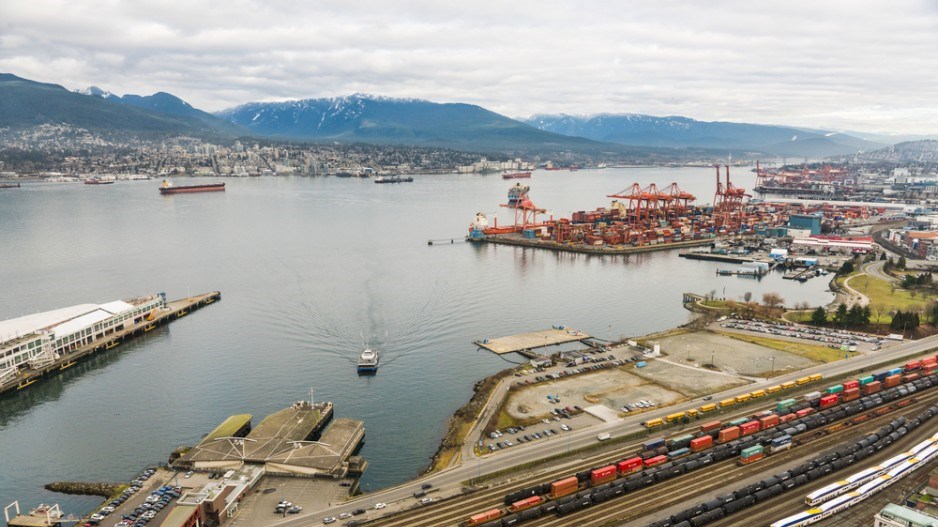Port congestion at Vancouver, Los Angeles and Long Beach is increasing cargo wait times and driving more shippers through the Panama Canal to East and Gulf coast ports, analysts say.
James Kyritsis, senior consultant with U.K.-based shipping consultancy Drewry Maritime Advisors, said the 2018 market share for the major North American West Coast container ports from B.C. to California was about 55% – the same as it was in 2017.
But, added Walter Kemmsies, managing director and chief strategist, ports, airports and global infrastructure, for JLL Ports (NYSE:JLL), West Coast bottleneck issues, combined with the trend among major ocean carrier companies to use larger, more fuel-efficient ships, are driving transpacific container traffic east.
A recent Drewry commentary noted that while transpacific cargo volumes dropped 3% in 2019’s first quarter compared with the same quarter in 2018, shipments to East and Gulf coast ports increased 4%.
Kyritsis and Kemmsies agreed that the potential for an escalation in the China-U.S. trade dispute skewed 2018 numbers as shippers worked to get cargoes into North America ahead of tariffs.
“About one-third of growth came from accelerated imports,” Kemmsies said.
Kyritsis added that the import surge would also negatively affect future port congestion, which Kemmsies said affects terminals, transportation infrastructure and real estate.
Kemmsies identified Vancouver, Seattle-Tacoma and Los Angeles-Long Beach as bottleneck sites.
“The congestion issues are very serious,” he said. “We’re seeing a lot of importers bringing things in through the East Coast and Gulf Coast.”
Some ports are adding new unloading cranes, but without yard abilities to store and move cargoes on, problems remain.
Kemmsies said with larger container ships carrying 14,000 20-foot-equivalent-unit (TEU) boxes arriving every few days, freight accumulates at the back of port yards and encroaches on waterside operations.
He added that slowdowns in container movement will send shippers looking for more efficient ports.
Kemmsies said a compounding factor on the horizon is the International Maritime Organization’s initiative to reduce the shipping industry’s sulphur oxide emissions by cutting the allowable sulphur content of marine fuels to 0.5% from 3.5% starting in January 2020.
That, he said, will mean more containers will be loaded onto fewer ships.
“The ports have to be ready to take larger ships or they face cargo losses.”
Port of Vancouver container terminals continue to invest in infrastructure improvement and expansion.
GCT Global Container Terminals Inc. plans to follow the completion in late 2018 of its $300 million GCT Deltaport rail densification project at Roberts Bank with a $160 million expansion of container cargo handling capacity at its Vanterm terminal in Vancouver.
DP World Ltd. (FRA:3DW), which operates Vancouver’s Centerm and Prince Rupert’s Fairview container terminals, plans to invest $300 million to increase Centerm’s capacity. It is also planning another expansion of Fairview.
Meanwhile, the Vancouver Fraser Port Authority (VFPA) is continuing to seek approval for its $3 billion Terminal 2 project at Roberts Bank.
But, as Business in Vancouver reported March 30, GCT is petitioning the Federal Court, seeking a judicial review of the VFPA’s refusal to process the company’s preliminary project inquiry to add a fourth berth at GCT Deltaport.
GCT also wants the court to prohibit a federal environmental review panel appointed by the Canadian Environmental Assessment Agency from holding a May 14 public hearing into the VFPA’s Terminal 2 project.
Kemmsies suggested that shifting more cargo to inland ports could reduce marine port congestion. He said China is moving quickly in that direction.
Kyritsis said Prince Rupert was among North American container ports with the strongest growth (11%) in 2018 compared with 2017 alongside Houston (10%), Montreal (9%), New York (8%) and Savannah (8%).
He added that Prince Rupert and Vancouver are expected to put competitive pressure on container terminals in Seattle-Tacoma and Los Angeles-Long Beach.
Kyritsis noted that Montreal gained market share over Halifax, Prince Rupert gained market share over Seattle-Tacoma and Vancouver, Savannah and New York gained market share over Norfolk.
Container shipping growth at Los Angeles-Long Beach was around 4% in 2018, which is lower than previous years, he said, and reflects potential market share loss to East and Gulf coast ports.
Kyritsis said the main impact of the expanded Panama Canal and its Neopanamax locks has been to reroute some Eastern Seaboard container services from the Suez Canal to the Panama Canal and allow larger ships to use it to service East and Gulf coast ports.
But he added that Drewry hasn’t seen a major shift in volumes between North America’s East and West coasts.
“There remains a significant transit time saving of going via the West Coast, which is one reason that makes this an attractive option.”
Kyritsis added that West Coast ports handle 50% of North America’s transpacific container trade.
Kemmsies said the US$5.25 billion widening of the Panama Canal, which was completed in 2016, has opened it up to larger transpacific container vessels, noting that 14,000-TEU ships are now regularly calling at Savannah, Norfolk, Charleston and New York.
Kyritsis said Drewry is projecting growth of around 4.4% for the North American market and expects its major East, West and Gulf coast ports to grow at similar rates.
But he added that numerous factors, including spare capacity, a port’s ability to handle larger vessels and its proximity to major markets, will drive market share.
Much of B.C.’s competitive edge has been the reliability of its West Coast ports due to labour peace, which was underscored during the 2014-15 labour disruption at U.S. West Coast ports that diverted some U.S. cargo traffic to Canadian ports.
However, as Business in Vancouver has reported (“Port Workers, Employers Still Talking but Still without a New Contract” – issue 1534; March 26–April 1), the landmark eight-year agreement that brought long-term labour peace to the Vancouver and Prince Rupert waterfronts expired in March 2018 and has yet to be replaced, even though new contract agreements between longshore unions and maritime employers at major U.S. ports have been negotiated. •
– With files from Timothy Renshaw




